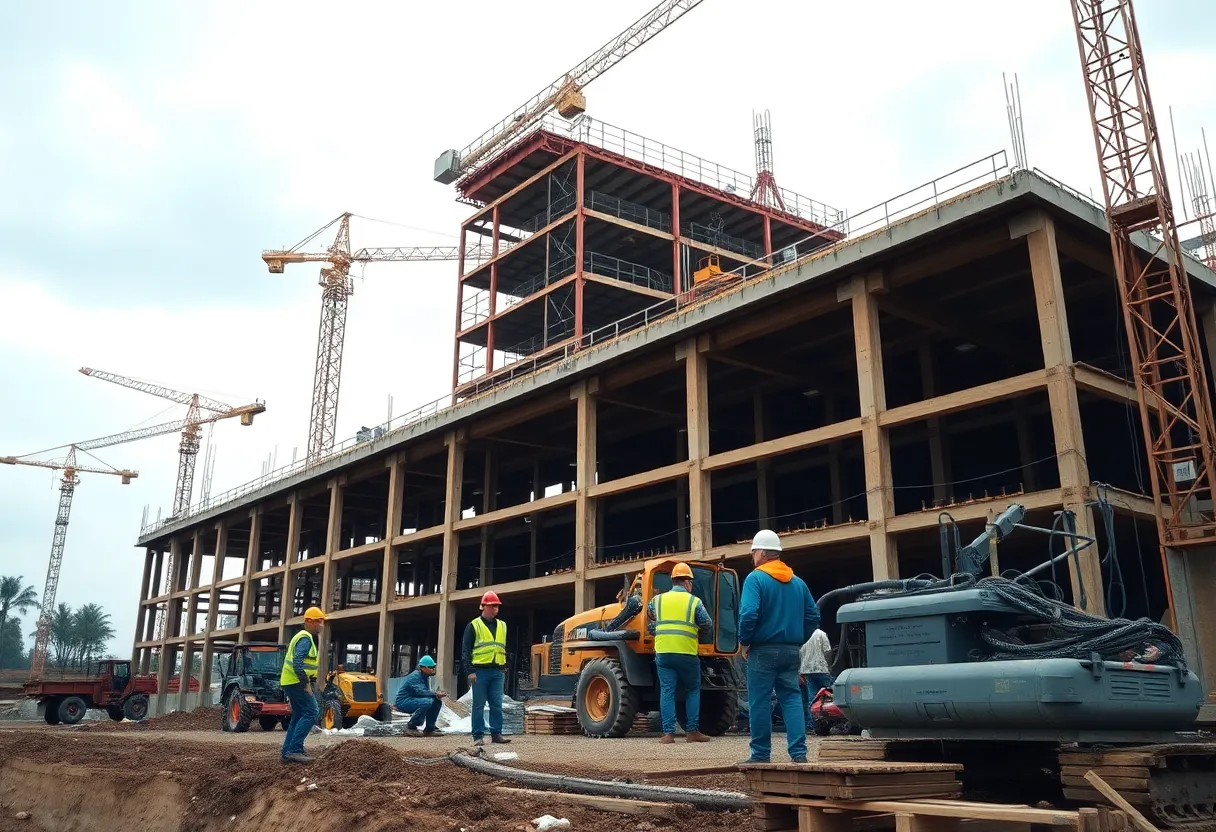News Summary
The construction and real estate sectors are currently battling a myriad of challenges due to economic slowdown, inflation, labor shortages, and cybersecurity risks. As global urban centers face these converging pressures, industry players must adopt innovative strategies to maintain project viability and competitiveness. The volatility in supply chains, coupled with geopolitical uncertainties, adds further complexity. Companies are encouraged to embrace comprehensive risk management frameworks that prioritize proactive decision-making to navigate this uncertain landscape and capitalize on emerging opportunities in infrastructure and technology.
Construction and Real Estate Sector Faces Converging Challenges in Major Markets
In key urban centres globally, the construction and real estate industries are experiencing a turbulent period marked by a confluence of economic, technological, and geopolitical pressures. These challenges are testing the resilience of players across the sector and demanding new strategies to navigate uncertain times.
Economic and Financial Pressures
One of the most pressing issues confronting the sector is economic slowdown coupled with persistent inflation. Rising prices for construction materials, including steel and copper, have led to significant cost escalations. This volatility complicates long-term project budgeting and increases the risk of delays and overruns. The scarcity of available financing and tightening liquidity conditions, especially in fragile markets, have caused many development plans to be postponed or canceled altogether.
One of the most common fiscal risks stems from cash flow concerns. Contractors and developers confront difficulties in maintaining reliable payments, which threatens their financial stability. The reliance on surety bonds and flexible financing options is increasingly viewed as a strategic approach to protect against potential insolvencies and ensure project continuity.
Supply Chain and Commodity Market Volatility
The industry continues to grapple with fragile supply chains, with disruptions impacting the timely delivery of essential materials. The unpredictability in prices of commodities such as steel, copper, and concrete is also escalating. These fluctuations, driven partly by geopolitical tensions and global market instability, make it harder for firms to lock in costs beforehand. Strategic procurement and contractual flexibility are essential to manage these risks effectively.
Digitalization and Cybersecurity Risks
As the industry adopts advanced digital tools such as Building Information Modeling (BIM) and artificial intelligence (AI), a new set of vulnerabilities has emerged. Construction sites and corporate systems often lack comprehensive cybersecurity infrastructure, making them highly vulnerable to cyber threats like ransomware, data breaches, and supply chain attacks. These digital threats pose serious risks to project timelines and financial integrity. Investing in robust cybersecurity measures, including endpoint protection and supply chain visibility, is critical for safeguarding assets and information.
Labor Shortages and Workforce Challenges
A significant concern is the labor shortage compounded by an aging workforce nearing retirement and a widening skills gap. This situation creates an experience vacuum at a time when digital expertise and technical skills are increasingly essential. The sector faces the dual challenge of attracting new talent and upskilling existing workers. Efforts to reposition the industry as an attractive career choice, alongside investment in employee development programs, are vital for maintaining a qualified workforce.
Competitive Pressures and Technological Innovation
The sector is witnessing increased competition, driven by rising infrastructure investments that attract new entrants and bidding wars for lucrative projects. To differentiate themselves, firms are prioritizing investments in technology such as virtual design models, automation, and AI to improve efficiency and project management. Digital transformation is crucial for staying competitive amidst evolving market demands.
Geopolitical and Market Uncertainties
Global geopolitical tensions and ongoing inflationary pressures have contributed to project delays and postponements. Political instability and fluctuating trade policies impose additional risks, complicating decision-making and investment planning. Many organizations are adopting stress-testing approaches to evaluate project viability across various economic scenarios, helping them to better prepare for potential downturns.
Holistic Risk Management Strategies
To address the extensive risk landscape, companies are urged to adopt comprehensive risk management frameworks that consider interconnected operational, financial, technological, and human capital risks. Emphasizing proactive decision-making rather than compliance alone is key. Incorporating factors such as corporate culture, employee engagement, and talent retention can also mitigate organizational vulnerabilities and improve resilience.
Looking Forward: Opportunities and Future Risks
Despite the current challenges, opportunities remain. Growth prospects are particularly promising in areas such as data centers, energy transition infrastructure, and urban regeneration projects. However, these areas require strategic foresight and adaptability to navigate the evolving risk environment.
The industry must contend with intensifying competition, cyber threats, and ongoing economic uncertainties while also addressing critical workforce issues. As digital and technological innovations continue to reshape the landscape, firms that adopt flexible strategies, diversify project portfolios, and reinforce cybersecurity and human capital will be better positioned to sustain growth and stability in the years ahead.
Deeper Dive: News & Info About This Topic
HERE Resources
Major Redevelopment Planned for Parkside Commons in Syracuse
Labor Shortages in D.C. Construction Due to Immigration Enforcement
Washington, D.C. Housing Market Remains Stable Amid Economic Concerns
Bus Driver Shortages Cause Disruptions and Legal Battles in Ohio and Michigan
Construction Internship Program Empowers High School Students
Kannapolis, NC, Sees Growth Spurring Construction Expansion
Construction Disruptions Impact Merced Businesses
Federal Workers Face Uncertainty Amid Ongoing Government Shutdown
Hudson School District Considers Closing Elementary Schools
D.C. Businesses Struggle Amid Federal Layoffs
Additional Resources
- Aon: How Human Capital Data Enhances Risk Management
- Investopedia: Human Capital
- Risk & Insurance: Human Capital Investment
- PR Newswire: Aon Appoints Andy Marcell as CEO
- J.P. Morgan: Importance of Human Capital Management
- Wikipedia: Human Capital
- Google Search: Construction Risk Management
- Google Scholar: Human Capital in Construction
- Encyclopedia Britannica: Risk Management
- Google News: Cybersecurity in Construction
Author: STAFF HERE WASHINGTON DC
The WASHINGTON DC STAFF WRITER represents the experienced team at HEREWashingtonDC.com, your go-to source for actionable local news and information in Washington, DC, and beyond. Specializing in "news you can use," we cover essential topics like product reviews for personal and business needs, local business directories, politics, real estate trends, neighborhood insights, and regional news affecting the area—with deep expertise drawn from years of dedicated reporting and strong community input, including local press releases and business updates. We deliver top reporting on high-value events such as the National Cherry Blossom Festival, Kennedy Center Honors, and the Washington Auto Show. Our coverage extends to key organizations like the Greater Washington Board of Trade and Destination DC, plus leading businesses in government contracting and technology that power the local economy such as Lockheed Martin and Amazon. As part of the broader HERE network, we provide comprehensive, credible insights into the dynamic landscape of the Washington metropolitan area.





